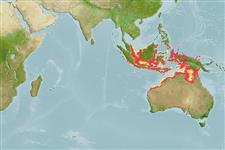Environment: milieu / climate zone / depth range / distribution range
Ekologi
laut berasosiasi dengan karang; nir-ruaya; kisaran kedalaman 2 - 52 m (Ref. 57178), usually 2 - 20 m (Ref. 90102). Tropical; 6°N - 22°S, 101°E - 145°E (Ref. 57385)
Indo-West Pacific: Singapore and Philippines to the western and northern coasts of Australia.
Size / Weight / umur
Maturity: Lm ? range ? - ? cm
Max length : 14.7 cm SL jantan/; (Ref. 6773)
Duri punggung (Keseluruhan (total)): 3; duri punggung lunak (Keseluruhan (total)): 12-13; Sirip dubur lunak: 6 - 8.
A benthic species (Ref. 75154) which occurs in inshore waters near reefs (Ref. 7300, 75154). Oviparous (Ref. 205). Egg clusters are attached to the side of the body of the male parent, either as brooding strategy or as aid in luring other fish for food (Ref. 6773). Solitary, usually under wharf pilings or among debris (Ref 90102).
Oviparous (Ref. 205). A clutch of eggs is attached to the side of the body of the male parent (Ref. 6773).
Kailola, P.J., 1987. The fishes of Papua New Guinea. A revised and annotated checklist. Vol. 1. Myxinidae to Synbranchidae. Research Bulletin No. 41. Department of Fisheries and Marine Resources, Port Moresby, Papua New Guinea. 194 p. (Ref. 6993)
Status IUCN Red List (Ref. 130435)
ancaman kepada manusia
Harmless
penggunaan manusia
Perikanan: tidak ada kepentingan
informasi lanjut
AcuanBudidaya airprofil budidaya airStrainGenetikaElectrophoresesDiturunkanPenyakit-penyakitPengolahanNutrientsMass conversion
mitraGambarStamps, Coins Misc.Suara-suaraCiguateraKecepatanTipe renangArea insangOtolithsOtakPenglihatan / visi
Alat, peralatan
laporan khas
muat turun XML
Sumber internet
Estimates based on models
Preferred temperature (Ref.
123201): 26.7 - 29, mean 28.3 °C (based on 570 cells).
Phylogenetic diversity index (Ref.
82804): PD
50 = 0.6250 [Uniqueness, from 0.5 = low to 2.0 = high].
Bayesian length-weight: a=0.01995 (0.00906 - 0.04395), b=3.01 (2.83 - 3.19), in cm total length, based on all LWR estimates for this body shape (Ref.
93245).
Trophic level (Ref.
69278): 3.9 ±0.7 se; based on size and trophs of closest relatives
Daya lenting (Ref.
120179): sedang, Waktu penggandaan populasi minimum 1.4 - 4.4 tahun (Fec = 650).
Fishing Vulnerability (Ref.
59153): Low vulnerability (10 of 100).
Nutrients (Ref.
124155): Calcium = 63.1 [29.8, 115.9] mg/100g; Iron = 0.652 [0.330, 1.198] mg/100g; Protein = 18.7 [16.2, 21.9] %; Omega3 = 0.122 [0.044, 0.308] g/100g; Selenium = 22.9 [9.7, 59.1] μg/100g; VitaminA = 231 [54, 938] μg/100g; Zinc = 1.12 [0.69, 1.80] mg/100g (wet weight);
